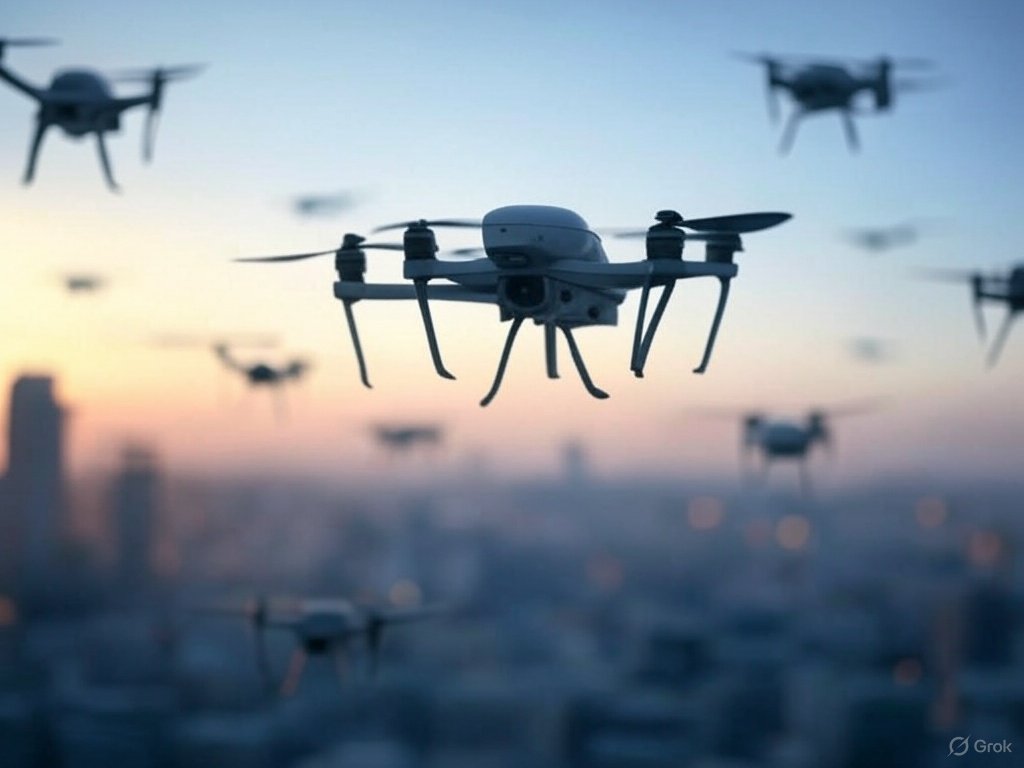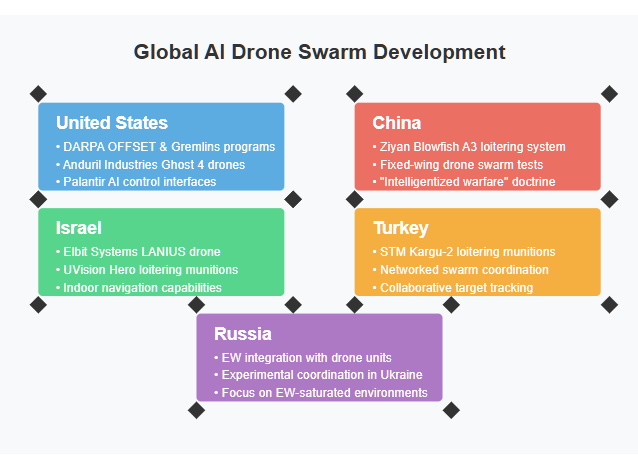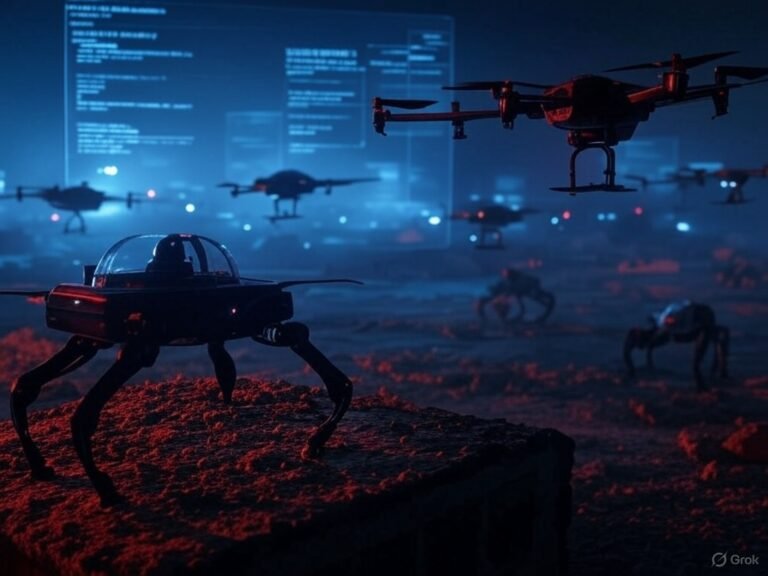
1. Introduction — From Eye in the Sky to Digital Pack Hunter
The next revolution in warfare won’t be a single stealth drone—it’ll be a coordinated swarm of autonomous aircraft, thinking together, moving as one, and capable of acting without real-time human control.
AI drone swarms are no longer experimental concepts confined to DARPA labs or tech demos. They’ve entered the global battlespace, deployed for reconnaissance, targeting, electronic warfare—and increasingly, for coordinated lethal strikes.
Unlike traditional drones, which rely on one-to-one control, swarms operate with decentralized logic. They share data, learn from each other, and adapt mid-flight to changing battlefield conditions. Some can identify threats, assign roles across the swarm, and execute maneuvers autonomously, turning clustered drones into digital pack hunters.
Countries like the U.S., China, Israel, and Turkey are all racing to develop, test, and deploy these systems—many of which are already in use across modern conflicts, including Ukraine.
This article explores how AI drone swarms work, who’s building them, and what they mean for the future of targeting, escalation, and the law of armed conflict.
2. What Are AI Drone Swarms and How Do They Work?
AI drone swarms are groups of unmanned aerial systems (UAS) that operate in coordination with one another using artificial intelligence, often without needing continuous human control. Unlike traditional drone formations—which follow pre-programmed flight paths or depend on centralized commands—swarms are built to be decentralized, adaptive, and collaborative.
Each drone in the swarm is equipped with sensors, processors, and communication tools that allow it to share data in real time with the other units. Using swarm intelligence algorithms, the drones can make collective decisions: identifying threats, assigning tasks among themselves, adjusting formations, and even deciding who strikes first.
Key features of advanced AI drone swarms include:
- Distributed Decision-Making: No single drone controls the rest; decisions emerge from the group.
- Edge AI Processing: Drones analyze data locally, avoiding latency from cloud or operator input.
- Autonomous Role Assignment: Drones can shift tasks (e.g., scout, jammer, loitering munition) dynamically as the mission evolves.
- Formation Agility: Swarms can split, regroup, or surround a target based on evolving battlefield input.
This level of coordination mimics natural behaviors seen in packs of wolves or flocks of birds—but translated into high-speed, armed, machine-driven combat logic.
Importantly, AI drone swarms don’t require human operators to assign every movement or targeting decision. That autonomy, while offering significant tactical advantage, also introduces major risks around control, accountability, and escalation—especially when deployed in complex environments.
3. Global Snapshot — Who’s Building and Testing AI Drone Swarms?
Over the past five years, AI drone swarms have shifted from lab prototypes to active military R&D—and in some cases, real-world deployments. Major military powers are racing to gain swarm capabilities for ISR, suppression of enemy defenses, and distributed lethality.
United States
The U.S. leads in advanced research through DARPA’s OFFSET and Gremlins programs, as well as commercial contractors like Palantir and Anduril Industries with its Ghost 4 drones in the context of Project Maven. The Army and Air Force are exploring swarm applications in multi-domain operations. Palantir and others are developing AI interfaces for swarm control and kill-chain integration.
China
China has invested heavily in autonomous aerial and naval swarms, including the Ziyan Blowfish A3, capable of carrying out loitering strikes. State media has showcased coordinated launch-and-strike tests involving dozens of fixed-wing drones. Analysts see AI swarms as central to China’s “intelligentized warfare” doctrine.
Israel
Israel’s Elbit Systems developed the LANIUS drone, an AI-guided loitering munition capable of autonomous indoor navigation and target identification. The Hero series from UVision blends swarmable tech with man-in-the-loop controls, offering flexible levels of autonomy.
Turkey
Turkey’s STM Kargu-2 gained global attention after a UN report suggested it was used autonomously in Libya in 2020. STM is also experimenting with networked swarm logic, enabling multiple drones to collaboratively track and engage targets.
Russia
While Russia lags in autonomous swarming, it is integrating electronic warfare units with drones in networked combat operations. Reports from Ukraine suggest drone teams are experimenting with low-level coordination, particularly in EW-saturated zones.
AI drone swarms are no longer theoretical. From battlefield ISR to autonomous strike missions, they’re becoming an integrated layer of military strategy—across at least five major defense ecosystems.

4. Tactical Capabilities — What Can Swarms Do?
The strength of AI drone swarms lies not in any single drone, but in their ability to act as a networked combat system—sharing data, reacting in real time, and executing complex missions that traditional drones or human pilots could not manage alone.
Here are several battlefield roles where swarms are already making an impact:
ISR and Reconnaissance
Swarms can blanket an area with distributed sensors, scanning terrain, identifying targets, and mapping enemy positions. When equipped with machine vision, they can detect movement, heat signatures, or specific object classes (e.g., vehicles, weapons emplacements).
Loitering and Strike Operations
Certain swarm drones can carry explosives or kinetic payloads, effectively acting as loitering munitions. They can identify a target, coordinate between units to decide which drone will strike, and continue the mission if one is destroyed.
Adaptive Behavior
With swarm intelligence, drones can assign roles dynamically—one might scout, another jam communications, while a third carries out a precision strike. If a drone is lost, another seamlessly replaces its function.
Urban Warfare and Indoor Navigation
Systems like Israel’s LANIUS are being designed for autonomous room-clearing operations, using AI to navigate tight environments and distinguish threats from civilians.
Overwhelm and Denial-of-Area
Swarms can saturate a zone, confuse enemy sensors, and trigger defensive overreaction—a form of soft psychological and electronic warfare. This capability is especially effective in anti-access/area denial (A2/AD) strategies.
In short, AI drone swarm tactics are designed to overwhelm both human decision cycles and machine defenses—compressing time, complicating response, and increasing the fog of war.

5. Strategic Risks — Escalation, Unpredictability, and Autonomy Gaps
⚠️ Escalation Without Attribution
Swarm behavior—especially when operating autonomously—can be unpredictable. If a swarm misidentifies a civilian vehicle or crosses into disputed territory, it could trigger a retaliation before human operators can intervene. The absence of centralized control makes it harder to pause, redirect, or clarify intent.
Emergent Behavior in Complex Environments
AI-driven swarms may develop behaviors not anticipated by programmers, especially in environments dense with variables (urban settings, EW zones, refugee corridors). A swarm might prioritize a target based on faulty heuristics—with lethal consequences – as a result of the prioritizing rewards over ethics.
Cyber and Communications Vulnerabilities
AI drone swarms rely on mesh networking and real-time data sharing. That makes them attractive targets for spoofing, jamming, or redirection. A hacked swarm could be weaponized by the adversary—or manipulated to trigger false-flag engagements.
Loss of Human Judgment
The core concern flagged by IHL experts is the delegation of life-and-death decisions to code. Even if human operators remain technically “in the loop,” real-time swarm dynamics may outpace their ability to respond meaningfully.
These challenges highlight a growing gap: AI drone swarms are advancing faster than the doctrines and legal frameworks needed to govern their use. The result is a battlespace increasingly defined by automation, opacity, and compressed timelines—where mistakes become harder to see and faster to escalate.

6. Are Drone Swarms Autonomous Weapons?
The question of whether AI drone swarms qualify as autonomous weapons systems (AWS) is more than academic—it determines how (or if) these systems are regulated under international humanitarian law (IHL).
The challenge lies in their structure: while many drone swarms still require initial human activation or target confirmation, others are increasingly capable of independent behavior—identifying, assigning, and attacking targets within the group without human input after launch.
Legal Grey Areas
If one drone in a swarm identifies a threat, relays that to others, and one drone carries out the strike autonomously—was there meaningful human control? If no human selected the specific target at the specific time, many legal scholars argue the threshold for AWS is crossed.
This aligns with the ICRC’s red line: autonomous systems that apply force to humans without human judgment must be prohibited. If AI drone swarms can assign lethal roles internally, even if each drone is semi-autonomous, the collective behavior may still violate these norms.
Doctrinal and Treaty Gaps
No current treaty explicitly addresses swarming behavior. Discussions within the UN Group of Governmental Experts on LAWS have stalled over definitions—especially for “emergent” or “collective autonomy.” This leaves a regulatory vacuum precisely where innovation is most aggressive.
As AI drone swarms continue evolving, they may bypass existing legal definitions altogether, forcing militaries, ethicists, and international bodies to rethink what constitutes autonomy—and who is responsible when it fails.
7. Conclusion — Coordinated, Lethal, and Just Getting Started
AI drone swarms aren’t a glimpse of future warfare—they’re already shaping its front lines. From reconnaissance to autonomous strike, their ability to coordinate, adapt, and act without centralized control represents a fundamental shift in how force is applied.
But with this transformation comes a profound set of challenges: ethical uncertainty, legal ambiguity, and the risk of unintended escalation in fast-moving combat zones. Swarm behavior may compress decision timelines and dilute accountability—exactly the conditions where mistakes become most dangerous.
As more nations experiment with and deploy these systems, the window to regulate or constrain their use is rapidly closing. Whether through treaty, doctrine, or technology safeguards, the question is no longer if AI drone swarms will define modern warfare—but on whose terms.




1 thought on “AI Drone Swarms: How Drones Are Learning to Hunt”